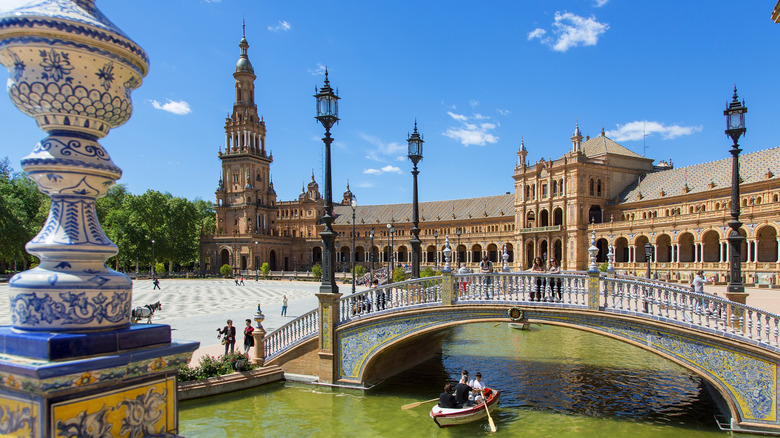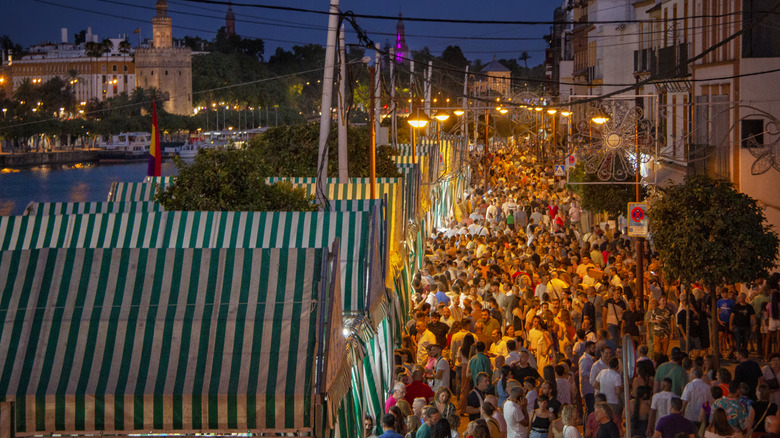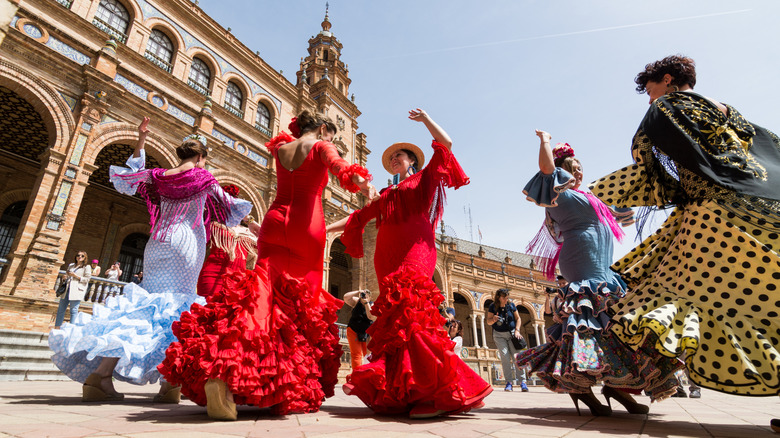Spain's 'Soulful' And Vibrant Southern City Rick Steves Referred To As A 'Perpetual Fiesta'
In the south of Spain, there is an old-world beauty named Seville (Sevilla in Spanish) that looks like it was constructed from a fairytale. It's what travel writer Rick Steves describes on his website as "soulful" and a "perpetual fiesta." After all, traditional flamenco dance and culture originated here, making his description pretty on brand. Located in the Andalusia region (or Andalucía), Seville is just under a three-hour train ride from Madrid, so after you're done eating your way through the iconic capital city known as one of Europe's best for foodies, you can take a day trip and taste the tapas in Seville.
You can't siesta on the fiesta in this Andalusian town because the party never ends. Women in vibrant flamenco dresses make the town come to life as annual fairs boast the city's magical ambiance. Seville has a complex range of celebrations that span from religious holidays to artistic and cultural events. Painters, sculptors, and poets have centuries of history in the Andalusia region, including the author of the epic novel "Don Quixote," Miguel de Cervantes, who was imprisoned in Seville at Castro del Río (Cordova). The city's annual festivals date back to the 19th century, and if one thing stays consistent, the Spanish community values tradition. Whenever there's an event, you'll find crowded streets, tents lined up with local cuisine, and dancing, making Seville a treat to visit.
Year-round celebrations to enjoy in Seville
While Spanish islands are known for their active social scenes — like Mallorca's hottest resort city known for its world-class nightlife and beaches or Ibiza, an iconic beach party destination that's overrated and expensive — Seville celebrates the local community and traditions that make the city what it is today.
Well-known festivities in Seville occur during Holy Week (Palm Sunday until Easter). According to Steves, the town transforms into party mode during this period. The Feria de Abril is the most-known festival, which began in the late 1840s. The fair covers about 24 blocks and passes through the town's amusement park, Calle del Infierno. Steve says, "Think of it as a week of all-nighters, with the focus on dancing, drinking, and socializing."
Festivals geared toward the arts scene include Los Carnavales in February, Bienal de Flamenco in the fall, and Feria de San Miguel in September. People will be dancing along the streets, playing instruments, singing, and twirling their bright-colored dresses. You'll also find many horses galloping the pathways, as equestrianism was passed down from generation to generation, significantly impacting Seville's culture. During these holidays, the majestic creatures help highlight the celebration and add to the town's storybook atmosphere.
Daily life and entertainment
Flamenco has made a rather large impression on Seville. The art form hit a pinnacle in the 19th and 20th centuries, as musicians and dancers were popular attractions in cafés. The flamenco guitar became a staple piece to the performance. Although the city's iconic festivals aren't a daily occurrence, people still go to bars and restaurants to watch talented performers strum the guitar, sing, and move their bodies to the music. Rick Steves says this local experience is a "flamboyant happening, with bystanders clapping along and encouraging the dancers with whoops and shouts." Each performance is moody and detailed, evoking an emotional reaction from those watching.
If you want to kick back with a cocktail and chat with good company, there is exciting nightlife in Seville, as well. You can visit places like Premier Garden Cocktail Bar or Premier Lagoh Cocktail Bar, which offers a cool outdoor atmosphere. Whether you're pulling an all-nighter at a festival in Seville, watching the traditional flamenco show, or grabbing a drink with your friends, you're going to want to put this awe-inspiring town on your bucket list.


